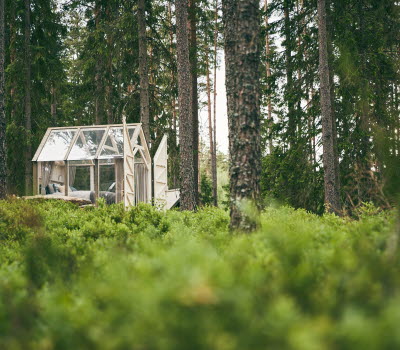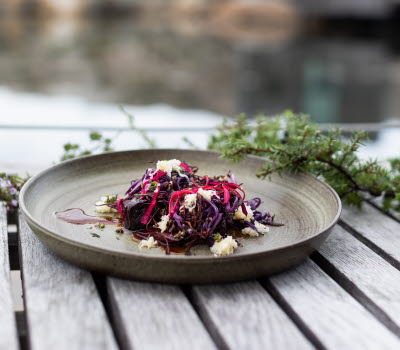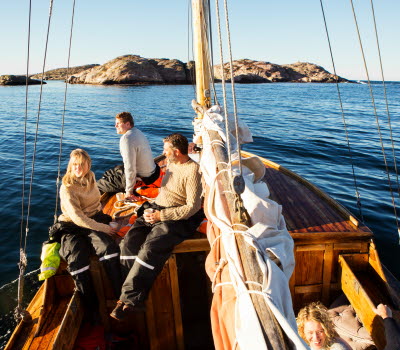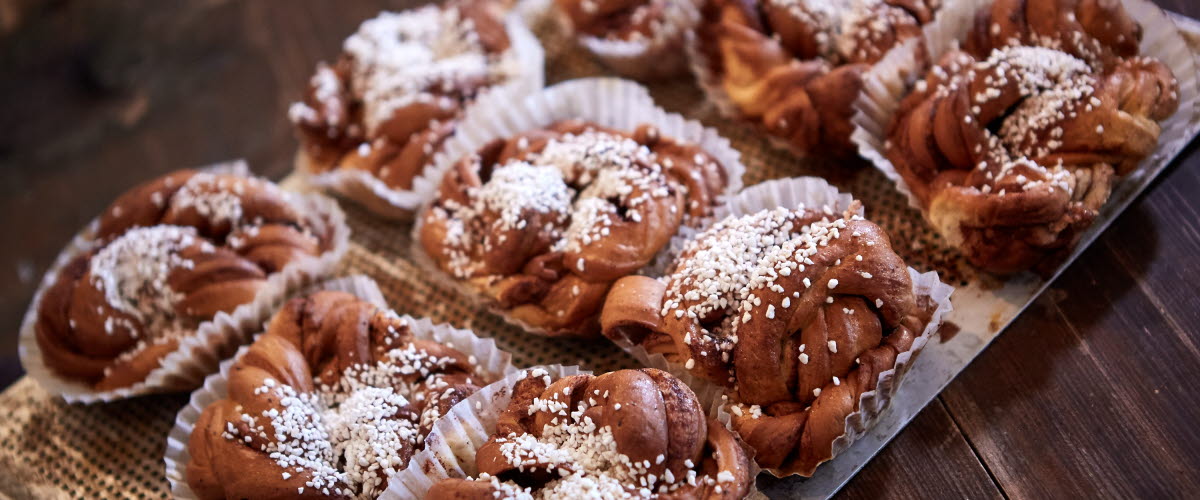How to celebrate Cinnamon Bun Day in West Sweden
In Sweden we love Cinnamon Buns so much that we created a special day for them – Cinnamon Bun Day, held on 4 October. To help you get in the mood here are some fun facts, a bit of history, a recipe and guide to some of West Sweden’s best cafes.
This is Cinnamon Bun Day
- A bun with its roots in the 1920s. The Roaring Twenties was when cinnamon buns started to be made in bakeries, at least in the form they are today. It was no coincidence that this sweet treat started to appear around then, when things that had been rationed during the First World War began to be sold in shops again. It was however after the Second World War that cinnamon buns became really popular in Swedish homes.
- Always the 4th October. Cinnamon Bun Day was started as a yearly celebration in 1999 by the Hembakningsrådet (the Home Baking Council), to mark the council’s 40th anniversary. Autumn was chosen for the actual day to be celebrated so that it didn’t clash with other important Swedish foods, like semlor (Lenten Buns), waffles, meatballs and surströmming (fermented herring).
- Seven million buns – in a day! Around seven million (!) buns are sold in Sweden on Cinnamon Bun Day. And of course you have to remember that that statistic doesn’t take into account all the buns baked at home. Around 57% of all Swedes are believed to eat at least one cinnamon bun on 4 October. And to give you an idea of how important Cinnamon Bun Day is to the Swedish fika tradition, we can tell you that at least half of all employers in Sweden treat their employees to cinnamon buns on the day. Probably around 3pm – on the dot – because it’s then that the hallowed fika break takes place in many companies.
What’s so special about Swedish Fika?
Swedish Fika has become an international concept, but what actually is it that’s so special about this Swedish tradition? Well, while other cultures have their cups of coffee on the hoof, the Swedish variant is more of a social institution. Having a ‘fika’ is a way of getting together and chilling out, and at the same time getting a much needed energy boost. You could describe cafes and patisseries as the Swedish equivalent of British pubs. It’s our other sitting room and a place where we love to meet up with friends and acquaintances. Did you know that refills are free at most cafés?
And did you know that fika is such an important part of the Swedish lifestyle that it is both a noun and a verb? The word has been used since the beginning of the 1900s and is said to be a playful anagram of the word for coffee then – kaffi. The tradition is however even older than that, and originated in Alingsås – the town that has come to be known as Sweden’s Fika Capital.
How much do Swedes ’fika’ then? After the Finns, Swedes consume the most coffee in the world – 9.19 kg per person, per year. That’s about 3 ½ cups of coffee per day. In their leisure time Swedes fika an average of 24 minutes per day, or 12 minutes at work. Men do it more often than women, but women do it for longer. The people of West Sweden fika more than any other Swedes. In total a West Swede fikas for 11 days per year. That’s a lot!
How to celebrate Cinnamon Bun Day in West Sweden
Most cafes and patisseries celebrate Cinnamon Bun Day, so you shouldn’t have any problems getting hold of a bun on 4 October. But how do you know which places make the tastiest buns? The best way is probably to try a few out out, and here are some tips on where to start your tasting.
Gunnebo Coffee House and Restaurant, at Gunnebo House and Gardens in Mölndal. The bakery has won the Swedish Mastership in Artisan Food several times, won medals for its excellent breadmaking, and been awarded Sustainable Café of the Year by White Guide Café. So it’s perhaps not exactly a secret that they know how to bake cinnamon buns as well.
Nolbygårds Organic Bakery and Cafe is on the outskirts of Café Town Alingsås. You’ll of course find many delicious kinds of fika here but Nolbygård’s speciality is the lovely atmosphere in the cafe, and their commitment to using organic produce in their bakery.
Lottas Bak & Form is a family run sour dough bakery on the island of Tjörn. Their use of organic and locally produced ingredients has brought them droves of regular customers. Have you ever tried buns made with sour dough?
Conditori Nordpolen in Vara has an elegant interior, with marble tables, crystal chandeliers and an extensive choice of fika. The staff are as lovely as the cakes are delicious!
Café på Klostret is in a beautiful setting in the countryside near Kinnekulle, with Lake Vänern a close neighbour. It has a lovely rustic atmosphere and makes the most of its pastoral location. Their delicious buns are lined up in different flavours.
Café Husaren, Göteborg. If you want extra sized buns make your way to Café Husaren in the district of Haga. The Haga Bun has been on the menu since the 80s and could, with its average 500g weight and plate sized diameter, be amongst the world’s biggest cinnamon buns. But don’t worry – you can share it!
Photographer: Jonas Ingman
Fika with a local
If you want to experience the Swedish fika tradition like a native, meet up with a local.
- Bake Swedish cinnamon buns with Anna. You can also join her and the dog Ronja for a nice walk around the lake in Norsesund.
- Bake Hallongrottor (literally ‘raspberry caves’) with Rob in Gothenburg. Bake a batch together and when they are done you can try them with a cup of coffee or tea.
- Meet Claes for Friday elevenses and talk about how to get into the Guinness Book of World Records – twice.
Read more about Meet the Locals
Bake your own buns – a recipe from the Hvita Hjorten restaurant
You can of course bake in your kitchen at home, and maybe surprise someone you like with the smell of home baked buns. We warmly recommend you try this recipe for Cardamom Buns from Läckö Castle’s Hvita Hjorten restaurant. A real touch of luxury!










